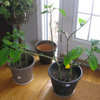Hi,
I was just thinking about the argument that the Strybing vulcanicola is a hybrid with B. sanguinea. The typical color form of B. sanguinea is red. I would naively assume a red coloration to be dominant in most cases. Are spontaneous yellow and orange seedlings among B. sanguinea seedlings common enough to suggest the presence of recessive gene(s) and the possibility that the Strybing vulcanicola could still have a red B. sanguinea as a parent? Or is it likely a yellow or orange sanguinea was the parent--if the plant is indeed a hybrid?
I'm also curious about reasons behind the limited distribution of B. vulcanicola in the wild. Is it possible that it is rare because it was harvested to near extinction by the indigenous people? If so, why were they interested in it?
Alternatively, one other possibility could be that B. vulcanicola is a cultivated variety (perhaps of B. sanguinea?) that was raised by the native people either for its appearance or perhaps more likely for its other properties. Would the known distribution of such a plant be consistent or inconsistent with such an idea? I think it would be naive to assume that the people in that part of the world would be incapable of cultivating a Brugmansia. Can such a possibility be ruled out?
Finally, a major objection to the Strybing vulcanicola being a pure vulcanicola is that it was presumably seed-grown. Plants from many different groups that are normally self-sterile can self-pollinate when pollen from an exogenous species is applied. The phenomenon is actually very common. Does this happen in Solanaceae and has it been ruled out for the Strybing B. vulcanicola?









brugmansiaddict
brugmansiaddict
Related Professionals
Lakewood Landscape Architects & Landscape Designers · Williamsburg Landscape Contractors · Braintree Landscape Contractors · Canton Landscape Contractors · Holland Landscape Contractors · Oklahoma City Landscape Contractors · Tehachapi Landscape Contractors · Palos Heights Landscape Contractors · Laurel Siding & Exteriors · Baltimore Siding & Exteriors · Levittown Siding & Exteriors · Hudson Roofing & Gutters · Miami Beach Roofing & Gutters · Roswell Roofing & Gutters · West Hills Decks, Patios & Outdoor Enclosuresbrugmansiaddict
brugmansiaddict
mark4321_gwOriginal Author
grrrnthumb
brugmansiaddict
brugmansiaddict
mark4321_gwOriginal Author
mark4321_gwOriginal Author
brugmansiaddict